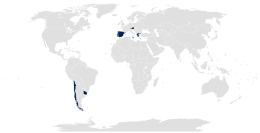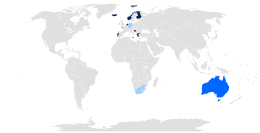Intersex rights in China
| Intersex rightsinChina | |
|---|---|
 Location of thePeople's Republic of China | |
| Protection of physical integrity and bodily autonomy | No |
| Protection from discrimination | No |
| Intersextopics |
|---|
 |
Intersex rights in Chinaincluding thePeople's Republic of China,theHong KongSpecial Administrative Region, etc., are protections and rights afforded tointersexpeople through legislation and regulation. Obligations also arise in United Nations member states that sign international human rights treaties, such as the People's Republic of China. Intersex people in China suffer discrimination. Issues include both lack of access to health care and coercive genital surgeries.[1]
History
[edit]In February 2018, Asian intersex activists published the Statement of Intersex Asia and the Asian Intersex Forum, setting out local demands.[2]
Physical integrity and bodily autonomy
[edit]
Small Luk(Hong Kong) describes traditional Chinese society as patriarchal, promoting the sex assignment of intersex children as boys wherever possible.[1]She states that the "one-child policy"in mainland China led to the abandonment, neglect and deaths of many intersex infants.
Both Luk[3]and Taiwan activistHiker Chiu[4]have disclosed personal histories involving unwanted medical interventions. Chiu says that surgical "normalisation" practices began in Taiwan in 1953.Intersex medical interventionsare encouraged as early as possible in both Hong Kong and the People's Republic. A 2014 clinical review of 22 infants withcongenital adrenal hyperplasiain Hong Kong, for example, shows that all infants in the study receivedclitorectomies.It also showed a preference for early surgeries when infants are aged 1–2 years, and an assessment of surgical success focusing on genital appearance and necessity for further cosmetic surgeries.[5]
The cost of medical interventions in the People's Republic of China makes medical treatment inaccessible, resulting in fewer coercive interventions but exacerbating health issues for some individuals,[6]and issues of abandonment and violence.[1]
In a submission to theUnited Nations Committee Against Torturein 2015, Beyond the Boundary - Knowing and Concerns Intersex raised concerns about lack of self-determination in Hong Kong and China, forced medical interventions in Hong Kong, lack of government assistance and marriage rights, and problems with violence and discrimination.[1]In a response to submissions for Hong Kong, the United Nations Committee published recommendations calling for the postponement of "non-urgent, irreversible medical interventions" until children are old enough to provide full, free and informed consent.[7]The committee called for an investigation into forced, involuntary and coercive practices in the People's Republic, along with measures to protect the autonomy and "physical and personal integrity of LGBTI persons".[8]
Protection from discrimination
[edit]
Press reports in 2015 and 2016 have provided examples of abandonment, neglect and even attempted murder. TheSouth China Morning Postreported the abandonment of an intersex baby in a part in Shandong province in mid-2015,[9]followed by allegations of attempts to murder an intersex infant as a "monster", in Henan province, in mid-2016.[10]
In 2017, the Hong KongEqual Opportunities Commissiontogether with the Gender Research Centre of the Hong Kong Institute of Asia-Pacific Studies at theChinese University of Hong Kongasked the Hong Kong government to introduce legislation offering protection against discrimination on the grounds ofsexual orientation,gender identityandintersex status.[11]
Remedies and claims for compensation
[edit]The United Nations Committee Against Torture has called for compensation for involuntary and medically unnecessary medical interventions in both the People's Republic of China and Hong Kong.[8][7]
Identification documents
[edit]Small Lukhas campaigned for self-determination of gender identity,[1]and also for third gender recognition in Hong Kong.[12]
Rights advocacy in Greater China region
[edit]The first people to publicly disclose being intersex wereHiker ChiuofOii-Chinese,based in Taiwan and founded in 2008,[13]andSmall Lukof Beyond the Boundary - Knowing and Concerns Intersex, Hong Kong, founded in 2011.[6]
Chiu started a "free hugs with intersex" campaign at Taipei's LGBT Pride Parade in 2010. Oii-Chinese also gives lectures and lobbies government.[13][14]The aims of Beyond the Boundary - Knowing and Concerns Intersex are to raise public awareness about intersex people and promote the rights of intersex people, including ending forced genital normalising surgery andconversion therapies.Luk urges the Hong Kong government to educate the public about intersex conditions, extendanti-discrimination lawsto cover intersex people and stop foisting surgery on intersex children without consulting them.[15]
See also
[edit]- Oii-Chinese
- Intersex rights in Taiwan
- Intersex human rights
- LGBT rights in China
- Transgender in China
References
[edit]- ^abcdeBeyond the Boundary - Knowing and Concerns Intersex (October 2015)."Intersex report from Hong Kong China, and for the UN Committee Against Torture: the Convention against Torture and Other Cruel Inhuman or Degrading Treatment or Punishment".Archivedfrom the original on 26 March 2017.
- ^Intersex Asia (February 2018)."Statement of Intersex Asia and Asian intersex forum".Retrieved5 September2018.
- ^Yau, Elaine (28 January 2016)."No child should endure my ordeal, says sex-disorder Hongkonger forced to be a boy".South China Morning Post.Archivedfrom the original on 5 April 2017.Retrieved25 March2017.
- ^Allain, Pierre-Henri (1 July 2015)."Sans contrefaçon, je suis fille et garçon".Libération.Archivedfrom the original on 3 July 2015.Retrieved2 July2015.
- ^Houben, Ch; Tsui, Sy; Mou, Jw; Chan, Kw; Tam, Yh; Lee, Kh (December 2014)."Reconstructive surgery for females with congenital adrenal hyperplasia due to 21-hydroxylase deficiency: a review from the Prince of Wales Hospital".Hong Kong Medical Journal.20(6): 481–485.doi:10.12809/hkmj144227.ISSN1024-2708.PMID25045882.
- ^abLuk, Small (20 October 2015),"Beyond boundaries: intersex in Hong Kong and China",Intersex Day,Intersex Day,archivedfrom the original on 5 April 2016
- ^abUnited Nations; Committee against Torture (2015)."Concluding observations on the fifth periodic report of China with respect to the Hong Kong Special Administrative Region".Geneva: United Nations.Archivedfrom the original on 26 March 2017.
- ^abUnited Nations; Committee against Torture (2015)."Concluding observations on the fifth periodic report of China".Geneva: United Nations.Archivedfrom the original on 26 March 2017.
- ^Lau, Mimi (24 August 2015)."Baby born with male and female genitals found abandoned in Chinese park".South China Morning Post.Archivedfrom the original on 12 November 2016.Retrieved25 March2017.
- ^Morgan, Joe (22 June 2016)."Father tries to kill intersex baby three times for being a 'monster'".Gay Star News.Archivedfrom the original on 26 March 2017.Retrieved25 March2017.
- ^Equal Opportunities Commission(9 March 2017)."EOC & GRC of CUHK Issue Statement Calling for the Introduction of Legislation against Discrimination on the Grounds of Sexual Orientation, Gender Identity and Intersex Status".Archivedfrom the original on 26 March 2017.
- ^Lam, Jeffie (3 December 2016)."Intersex Hongkonger wages one-person campaign for third gender recognition".South China Morning Post.Retrieved25 March2017.
- ^ab"Neither here, nor there".Taipei Times.27 November 2013.Archivedfrom the original on 4 July 2015.
- ^"Ôm âm dương nhân hệ liệt 2: Đình chỉ làm cho thẳng giải phẫu âm dương nhi không phải dị hình".Lihpao Daily.23 December 2013. Archived fromthe originalon 3 July 2015.
- ^"Người song tính tinh tế lão sư: Cưỡng bách tiểu đồng làm bộ phận sinh dục chỉnh sửa giải phẫu cùng cấp khổ hình".Passion Times. 24 November 2015.Archivedfrom the original on 4 April 2016.
Bibliography
[edit]- Beyond the Boundary - Knowing and Concerns Intersex (October 2015)."Intersex report from Hong Kong China, and for the UN Committee Against Torture: the Convention against Torture and Other Cruel Inhuman or Degrading Treatment or Punishment".
- United Nations; Office of the High Commissioner for Human Rights (2015)."Free & Equal Campaign Fact Sheet: Intersex"(PDF)(in Chinese).
- United Nations; Committee against Torture (2015)."Concluding observations on the fifth periodic report of China".Geneva: United Nations.
- United Nations; Committee against Torture (2015)."Concluding observations on the fifth periodic report of China with respect to the Hong Kong Special Administrative Region".Geneva: United Nations.
